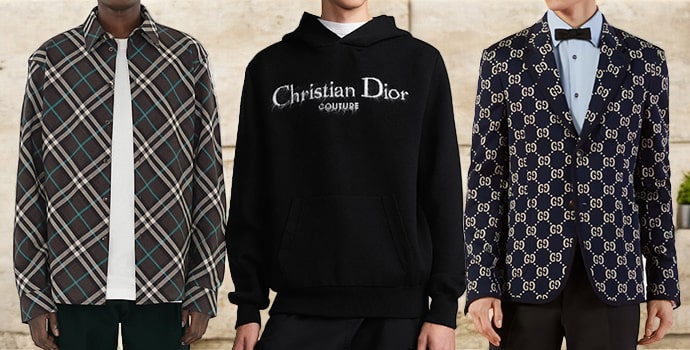Branded Clothing for Travel: Wrinkle-Resistant Fabrics That Perform
Branded Clothing for Travel: Wrinkle-Resistant Fabrics That Perform
Blog Article
The Relevance of Lasting Clothing: How It Impacts the Environment and Your Storage room
Sustainable garments is progressively identified for its important function in minimizing the ecological effect of the fast fashion business. By concentrating on environmentally friendly materials and ethical manufacturing techniques, it resolves pushing environmental concerns. This change not only benefits the world however additionally influences consumer choices, causing a more thoughtful approach to wardrobe management. Understanding these dynamics raises crucial inquiries regarding fashion's future and individual responsibility fit it.
The Environmental Impact of Fast Fashion

Benefits of Lasting Materials
Lasting products offer substantial advantages, specifically via green material choices that reduce environmental harm. These materials also show durability and longevity, reducing the need for constant replacements. Therefore, they add to an extra sustainable garment industry and promote accountable customer behavior.
Eco-Friendly Textile Options
While the fashion business has actually long been connected with rapid patterns and ecological damage, the rise of environmentally friendly textile options presents a transformative chance. Lasting products such as natural cotton, hemp, and Tencel have acquired appeal due to their lower environmental effect. These materials are commonly created without damaging chemicals and require less water, decreasing their carbon impact - Branded Clothing. Additionally, numerous green materials are biodegradable, contributing to a round economic climate by lessening waste. Picking lasting products not just supports environmentally accountable methods yet additionally promotes much healthier communities. As customers end up being more knowledgeable about their purchasing power, the demand for eco-friendly textiles encourages brands to introduce and adopt more sustainable manufacturing methods, ultimately profiting the earth and future generations
Toughness and Longevity Benefits
Lots of customers are progressively identifying the longevity and long life benefits of lasting materials in their apparel choices. Unlike standard textiles, lasting products such as organic cotton, hemp, and recycled polyester are engineered to withstand deterioration, causing garments that last much longer. This minimized regularity of replacement not just conserves consumers money in time but also reduces waste generated by quick fashion. Additionally, sustainable apparel commonly employs green production techniques that improve fabric toughness, contributing to a decrease in the overall carbon footprint. By buying durable clothes, consumers can grow a much more sustainable closet while delighting in top notch items that preserve their aesthetic and performance over time. Subsequently, longevity and durability stand as essential benefits of choosing lasting products.
Minimizing Waste Via Sustainable Practices
Minimizing waste in the fashion business can be accomplished via innovative techniques such as upcycling and repurposing products. Additionally, embracing minimalist wardrobe approaches encourages customers to focus on top quality over amount, inevitably reducing clothes consumption. Together, these approaches contribute considerably to an extra lasting clothes version.
Upcycling and Repurposing Materials
Upcycling and repurposing products have arised as ingenious techniques in the fashion business, transforming discarded textiles into beneficial new items. This method not only decreases waste however additionally urges creative thinking and originality in apparel style. By taking old garments and materials, designers can create special items that reflect personal design while minimizing the need for new sources. Furthermore, upcycling usually needs less power and water compared to standard manufacturing procedures, significantly decreasing the environmental impact of fashion. As customers become extra aware of sustainability, the popularity of upcycled clothing remains to climb, advertising a circular economic climate. Ultimately, these practices add to website here a much more lasting future, where style focuses on environmental wellness over rapid manufacturing and usage.

Minimalist Closet Strategies
As people increasingly look for to lessen their ecological influence, embracing minimalist wardrobe techniques has actually gotten traction as an effective approach to sustainable fashion. These approaches highlight high quality over quantity, encouraging consumers to curate a smaller collection of functional, durable apparel. By focusing on classic pieces that can be combined and matched, people can decrease the frequency of acquisitions and eventually reduce waste.Additionally, minimalism advertises conscious intake, prompting consumers to review the ethical and ecological effects of their selections. This strategy not only cultivates an extra sustainable lifestyle however likewise streamlines day-to-day decision-making relating to outfit. As individuals welcome minimalist concepts, they add to a fashion society that values sustainability and liable consumerism, inevitably causing a more eco-conscious society.
The Duty of Moral Labor in Sustainable Fashion
While numerous customers are increasingly familiar with the environmental effects of their clothing choices, the importance of moral labor methods in lasting fashion can not be overlooked. Ethical labor includes fair earnings, secure working problems, and respect for workers' legal rights, creating the foundation of liable style manufacturing. Brands that prioritize ethical labor not just uplift areas yet also established a criterion for responsibility in the industry.Moreover, the combination of ethical practices fosters openness, enabling customers to make educated selections regarding their purchases. This method contrasts greatly with rapid fashion's exploitative labor models, which often prioritize earnings over people. By sustaining companies dedicated to honest labor, consumers add to a system that values human self-respect alongside environmental sustainability. Moral labor is not simply an add-on; it is crucial to the broader objective of lasting fashion, making sure that the pursuit for eco-friendliness does not come at the cost of human legal rights.
The Influence of Sustainable Garments on Carbon Emissions
Sustainable clothes has the prospective to substantially lower carbon emissions connected with the garment industry. Conventional garment manufacturing adds especially to greenhouse gas emissions, mostly due to energy-intensive production processes and the use of non-renewable resources. On the other hand, sustainable fashion concentrates on environment-friendly materials, such as natural cotton or recycled fibers, which often require much less power to produce.Moreover, sustainable brand names have a tendency to adopt a lot more effective manufacturing practices, decreasing waste and reducing overall exhausts. By focusing on sturdiness and classic layout, lasting clothing urges customers to acquire much less frequently, more decreasing the carbon impact connected with overconsumption.Additionally, many sustainable brands are committed to transparency in their supply chains, allowing consumers to make informed choices that align with their values. Inevitably, shifting towards sustainable apparel can cause a substantial decrease in carbon discharges, adding to a healthier planet and a much more lasting future for the fashion business.
Sustaining Neighborhood Economic Climates With Lasting Options
The change towards lasting garments not just addresses ecological concerns however additionally significantly benefits local economies. By picking lasting fashion, consumers commonly support neighborhood craftsmens and local business, boosting area resilience. These enterprises usually operate a smaller sized scale, prioritizing craftsmanship and moral practices over mass production.Investing in locally made sustainable clothes cultivates task creation and promotes financial development within neighborhoods. As consumers come to be much more mindful of the ecological effect of their purchases, they progressively look for products that mirror their values. This demand motivates neighborhood manufacturers to adopt sustainable methods, contributing to a round economy.Moreover, sustaining local services lowers transport exhausts, straightening with eco-conscious customer habits. The interconnectedness of lasting garments and regional economic climates underscores the necessary function that private selections play in promoting both financial and environmental health. By cultivating these local links, communities can thrive while likewise working in the direction of an extra lasting future.
Transforming Your Closet: Tips for a Sustainable Closet
As people seek to reduce their ecological influence, changing a wardrobe right into a sustainable closet comes to be Learn More a crucial action. One effective technique is to review existing garments, keeping only products that are used frequently which align with sustainability objectives. Focusing on quality over quantity is crucial; buying check over here long lasting pieces from environmentally friendly brands can substantially reduce waste.Additionally, integrating used products can rejuvenate a wardrobe while reducing environmental damage. Organizing apparel swaps with friends or donating unused items can even more advertise sustainability.When buying, people need to seek products that are natural, recycled, or naturally degradable, and stay clear of fast fashion stores - Branded Clothing. Practicing mindful consumption by attentively thinking about each purchase can contribute to a more lasting way of life. By applying these ideas, one can create a closet that mirrors personal design while sustaining ecological stewardship
Regularly Asked Questions
How Can I Recognize Sustainable Garments Brands?
To recognize lasting apparel brand names, one must investigate products utilized, inspect for accreditations like Fair Profession, and check out the brand name's openness regarding their production processes, labor practices, and environmental impact, making sure environmentally friendly and moral methods are focused on.
What Are the Expenses Related To Sustainable Fashion?
The prices related to sustainable style can differ significantly. Higher manufacturing expenses, ethical sourcing, and green materials typically cause raised retail rates, which may discourage some consumers while attracting eco conscious consumers.
Can Lasting Clothes Be Elegant and Stylish?
Lasting apparel can certainly be stylish and elegant. Developers significantly focus on ingenious materials and honest manufacturing approaches, confirming that fashion and sustainability can coexist. Consumers now have diverse choices that blend visual appeals with ecological consciousness.
Exactly How Does Washing Clothes Affect Their Sustainability?
Washing clothes greatly influences sustainability by consuming water and power, adding to contamination, and causing microplastic release. Constant washing can weaken materials, reducing their life-span and raising the requirement for substitutes, eventually worsening environmental concerns.
What Is the Lifespan of Lasting Clothes Contrasted to Fast Fashion?
The life expectancy of lasting clothing usually goes beyond that of rapid fashion products, usually long-term numerous years as a result of high quality products and workmanship. On the other hand, fast fashion garments may weaken rapidly, necessitating even more constant replacements. Lasting clothing is progressively acknowledged for its critical role in decreasing the environmental impact of the rapid fashion industry. While lots of customers are increasingly mindful of the ecological effects of their clothing options, the value of honest labor methods in sustainable fashion can not be ignored. Branded Clothing. Sustainable clothing has the possible to considerably minimize carbon discharges associated with the style sector. In contrast, lasting style focuses on eco-friendly products, such as natural cotton or recycled fibers, which frequently need much less energy to produce.Moreover, lasting brand names have a tendency to take on much more reliable production practices, decreasing waste and decreasing overall emissions. By prioritizing resilience and timeless layout, lasting garments urges customers to purchase less often, more minimizing the carbon impact associated with overconsumption.Additionally, many lasting brand names are dedicated to openness in their supply chains, enabling consumers to make informed choices that straighten with their worths
Report this page